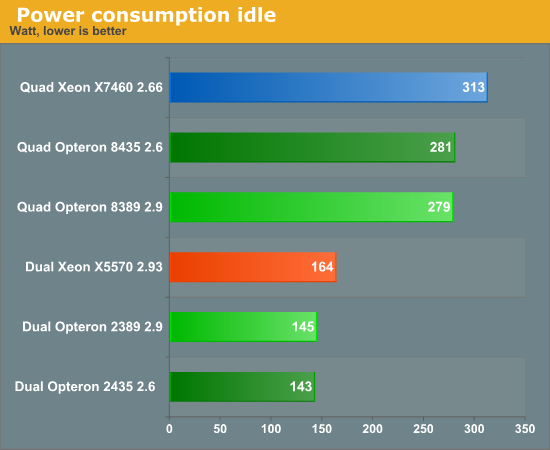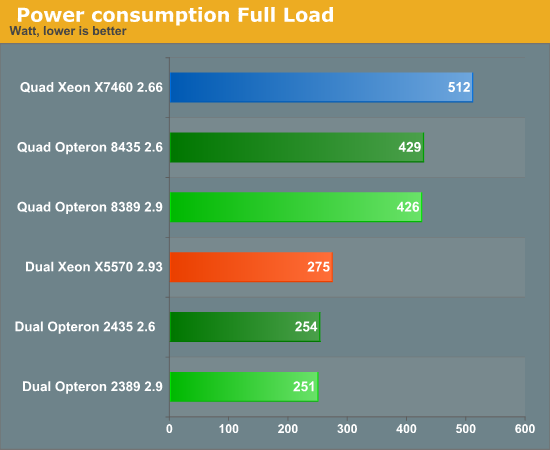Expensive Quad Sockets vs. Ubiquitous Dual Sockets
by Johan De Gelas on October 6, 2009 1:00 AM EST- Posted in
- IT Computing
Power Consumption
We have already done fairly comprehensive power consumption comparisons; note however the numbers of the dual Xeon X5570 are higher than in that article. The reason is that we use the 1U ASUS RS700-E6 and not one of the nodes in the ASUS twin server. The latter server has been sent back to ASUS, and the 1U model is of course a better choice if you want to compare with the other servers in this review, which are all single node servers. We notice that our ASUS RS700-E6 consumes about 12W more than the node of the ASUS twin, which has a smaller motherboard with slightly less features.
As the Dual Xeon X5570 had only 24GB, we determined how much one DIMM adds to the idle and full load power, and we added that power to the numbers measured. So all dual socket servers have 32GB of RAM, while the quad socket servers have 64GB of RAM. The reason is that we like to know what will happen if we replace two dual socket servers by one quad socket.

A software bug in ESX is the reason why most servers - except Intel's - are not able to use EIST when running ESX 4.0 (VMware vSphere 4). This bug will be solved in ESX 4.0 SP1, which will be out at the end of this year. ASUS did not want to wait and circumvented the problem by adapting their BIOS. Thumbs up to ASUS for addressing this problem at such short notice. All the servers were able to use power saving features on ESX, as the AMD platform does not suffer from the ESX bug. To our surprise, enabling EIST did not decrease the power significantly: we went from 165W to 162W. So far as we know, there are no tools that can read out CPU clock and voltage data, so we have no way of verifying what is going on. Enabling AMD's PowerNow! causes a drop of about 10%. A possible explanation is that EIST does work, but that the PCU (Power Control Unit) of the Xeon x55xx is already shutting down so many parts of the die that the CPU sips very little power in idle and there is little room for any improvements. Our measurements were confirmed when we measured with and without EIST on Intel's low power optimized "Willowbrook/Chenbro" server.
The problem that the quad socket servers have is immediately apparent: they consume close to twice as much as the dual socket platform. That is rather bad news for the quad socket servers: it means that buying one large server instead of two dual does not result in any tangible power saving. One of the reasons is that for example our dual hex-core Opterons work together with very efficient 650W power supply, while our quad socket platform is using a relatively heavy 1200W PSU. Quad socket platforms still have a lot of room for improvement when it comes to power efficiency. What is worse is that the performance/watt of the dual servers is clearly better. Let us check the power numbers are full load.

Again, the quad machines do not really convince us that they may save us a lot of power, especially from the performance/watt point of view. If you are not performance limited but memory limited, the quad machines might still make some sense.










32 Comments
View All Comments
rbbot - Tuesday, October 6, 2009 - link
Surely the high price of 8GB Dimms isn't going to last very long, especially with Samsung about to launch 16GB parts soon.Calin - Wednesday, October 7, 2009 - link
8GB DIMMs have two markets: one would be upgrade from 4GB or 2GB parts in older servers, the other would be more memory in cheaper servers. As the demand can be high, it all depends on the supply - and if the supply is low, prices are high.So, don't count on the price of 8GB DIMMs to decrease soon
Candide08 - Tuesday, October 6, 2009 - link
One performance factor that has not improved much over the years is the decrease in percentage of performance gains for additional cores.A second core adds about 60% performance to the system.
Third, fourth, fifth and sixth cores all add lower (decreasing) percentages of real performance gains - due to multi-core overhead.
A dual socket dual core system (4 processors) seems like the sweet spot to our organization.
Calin - Wednesday, October 7, 2009 - link
If your load is enough to fit into four processors, then this is great. However, for some, this level of performance is not enough, and more performance is needed - even if paying four times as much for twice as much performancehifiaudio2 - Tuesday, October 6, 2009 - link
FYI the R710 can have up to 192gb of ram...12x16GB
not cheap :) but possible
JohanAnandtech - Tuesday, October 6, 2009 - link
at $300 per GB, or the price of 2 times 4 GB DIMMs, I don't think 16 GB DIMMs are going to be a big success right now. :-)wifiwolf - Wednesday, October 7, 2009 - link
for at least 5 years you meanmamisano - Tuesday, October 6, 2009 - link
Great article, just have a question about the power supplies. Why do the quad-core servers need a 1200W PSU if the highest measured load was 512W? I know you would like to have some head-room but it looks to me that a more efficient 750 - 900W PSU may have provided better power consumption results... or am I totally wrong? :)JarredWalton - Tuesday, October 6, 2009 - link
Maximum efficiency for most PSUs is obtains at a load of around 40-60% (give or take), so if you have a server running mostly under load you would want a PSU rated at roughly twice the load power. (Plus a bit of headroom, of course.)JohanAnandtech - Wednesday, October 7, 2009 - link
Actually, the best server PSUs are now at maximum efficiency (+/- 3%) between 30 and 95% load.For example:
http://www.supermicro.com/products/powersupply/80P...">http://www.supermicro.com/products/powersupply/80P...
And the reason why our quads are using 1000W PSUs (not 1200) is indeed that you need some headroom. We do not test the server with all DIMM slots filled and you also need to take in account that you need a lot more power when starting up.